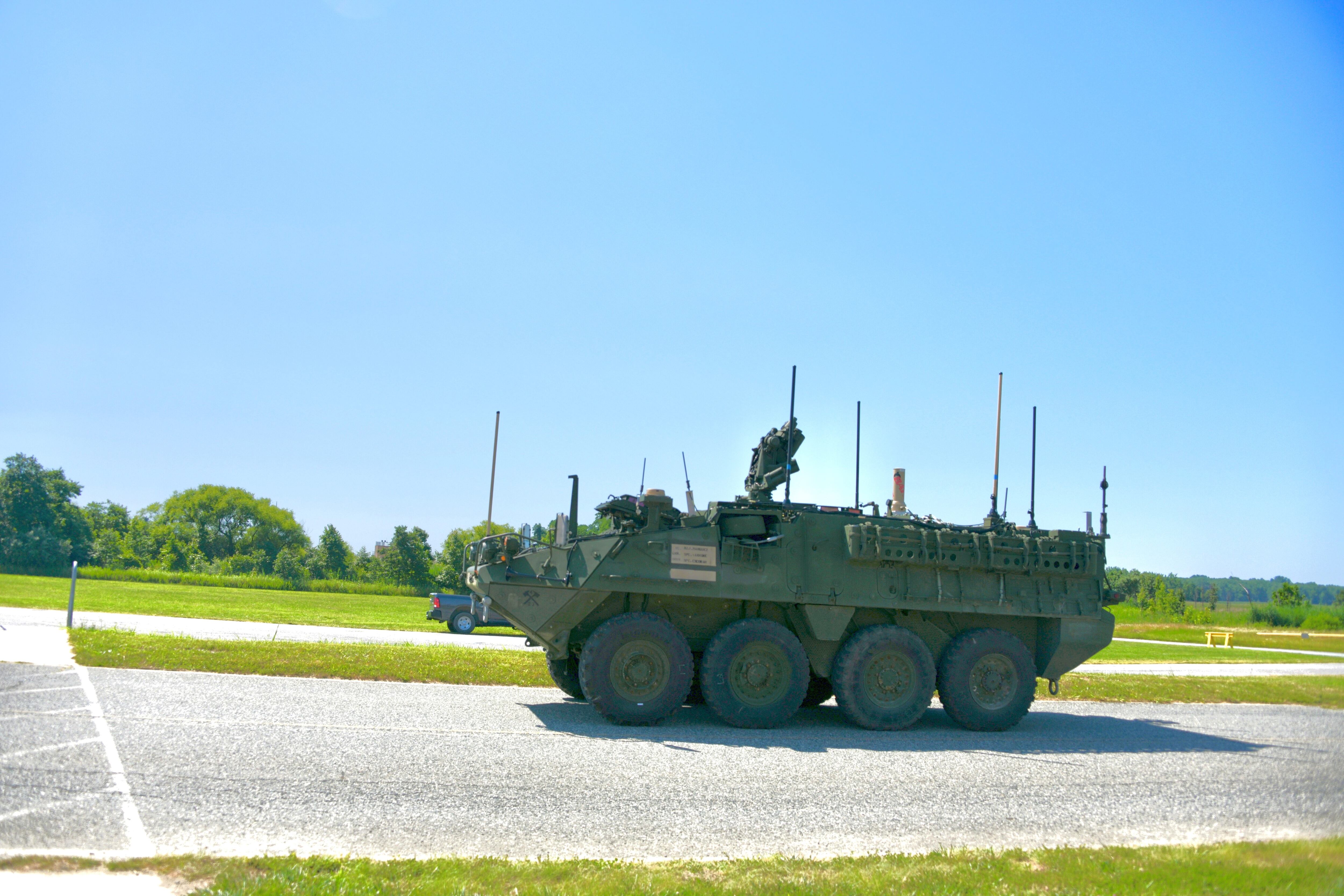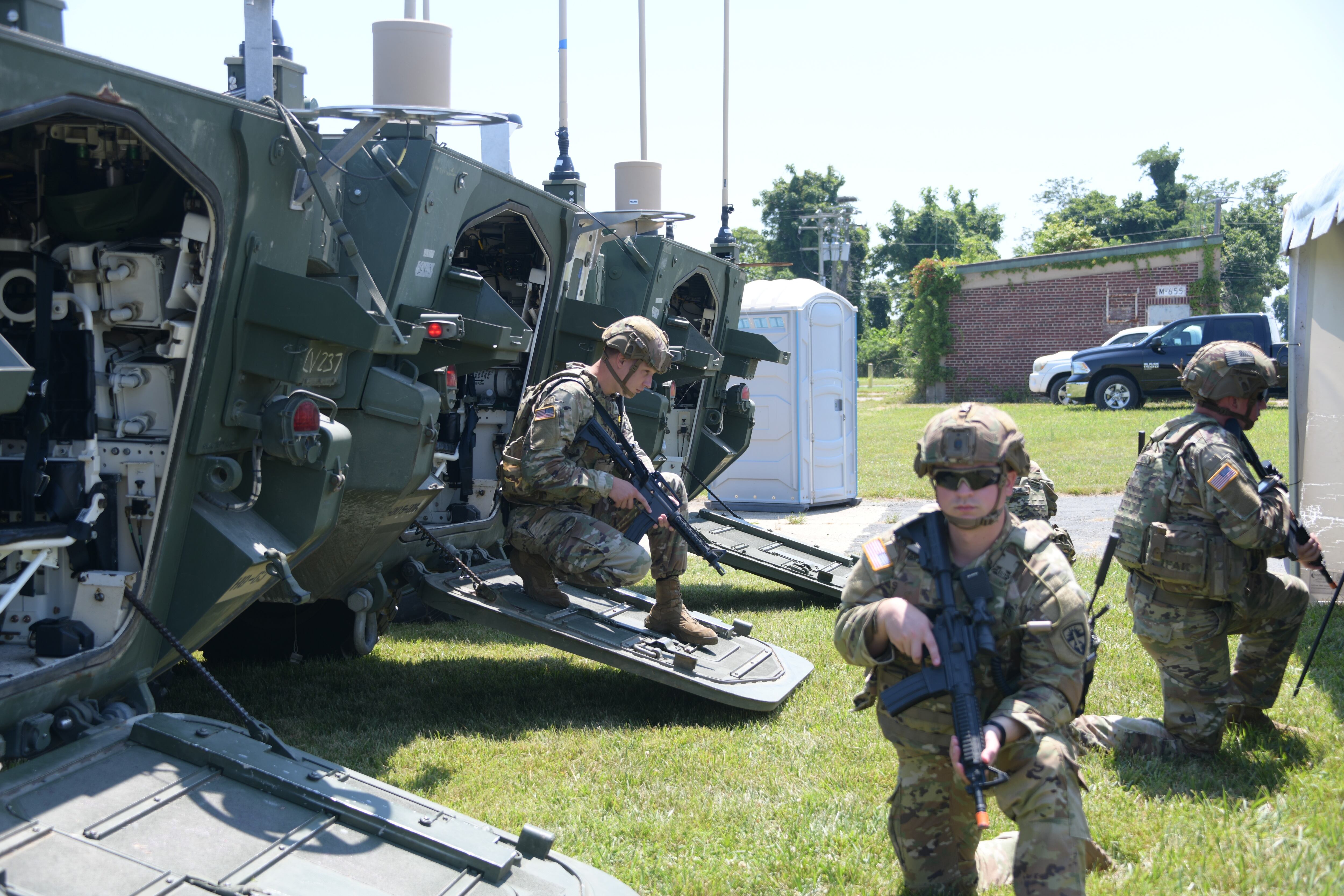ABERDEEN PROVING GROUND, Md. — The Stryker armored vehicle hatch dropped. Soldiers scrambled out, aiming immediately at enemy positions as they dismounted.
In the future, soldiers sealed inside Strykers will learn the locations of their objective and enemy soldiers, watching on a screen the virtual pins dropped by other soldiers on mobile devices strapped to their chests. At this demonstration at Aberdeen Proving Ground last month, the Stryker teams entered the fight and traversed the battlefield to a mock Islamic State group weapons cache while their locations, in turn, pinged to soldiers and vehicles across the Stryker brigade.
“When you’re in a fight, things are always moving around. I thought it was very useful to have as a soldier because before you even drop that ramp you know what to expect,” said Sgt. Connor Smith, who took part in the demo.
This is the Army’s battlefield network of the future for Stryker brigades. No longer will soldiers have to scan the battlefield after the hatch falls to find the enemy. Soon, new tactical network tools will show soldiers inside a Stryker where enemy soldiers are positioned before they dismount, marked by other soldiers on the battlefield.
“You know that, ‘Hey I’m positioned this way, my enemy’s right there.’ So if I get out the Stryker, I’m going to aim that way when I get out,” said Col. Garth Winterle, project manager for tactical radios with the Army Program Executive Office Command, Control, Communications-Tactical. “Or the vehicle commander can position the vehicle so I’m not in the line of fire.”
For the last several years, the Army worked to outfit several infantry brigades with dismounted tactical network tools that increase situational awareness and enhance battlefield communication. With that effort nearing completion, the exercise at Aberdeen last month was a critical step in designing how the Army’s new integrated tactical network tools will fit onto Stryker platforms for its next iteration of tactical network tools, known as Capability Set ’23.
“What we see in the Strykers really is really cool because it does fundamentally change how our soldiers see the battlefield,” said Maj. Gen. Anthony Potts, head of Program Executive Office Soldier.

PEO C3T, the Army’s Network Cross-Functional Team and its research partner the C5ISR Center, which makes up the core of the service’s tactical network modernization located at APG, are now working to modify tactical network tools to fit into Stryker vehicles and set a common baseline for future capability sets. That way, the tactical network team doesn’t have to “redesign the whole thing” for each new capability set.
The group is working with the 2nd Cavalry Regiment in Vilseck, Germany, to integrate Capability Set ’21 tools onto Strykers and help improve the network design of Capability Set ’23, which undergoes critical design review in April next year.
The service is integrating several new hardware tools onto Strykers, including tactical servers and Wi-Fi capabilities, to improve soldiers’ situational awareness. The Army wants Stryker vehicles to connect to each other and dismounted soldiers both on-the-move and at-the-halt. The service plans out outfit 64 vehicles in the 2nd Cavalry Regiment with the CS21 gear and is running a communications exercise before the Stryker brigade goes to Saber Junction, a major United States Army Europe and Africa exercise.
Perhaps most importantly, company commanders’ vehicles will have a tool that integrates unclassified and classified data into a single common operating picture — a small box called a cross-domain solution, a critical new capability for commanders. Winterle said that commanders usually have a secret and unclassified common operating picture, but they have never been integrated.
“[By] actually putting the cross-domain solution on platform, you’re getting that integration right there on the platform for the first time so that the vehicle commander ... can now see everything. Vehicle icons, he can see his dismounts,” Winterle said. “He’s got full visibility of where things are so if he has to call for fire or he has to make key decisions on maneuver, or link up to reload his dismounts, he can do that on one screen.”
Network modernization is a priority for the Army as it prepares for future conflicts against advanced adversaries including China and Russia, and it requested a $537 million increase over fiscal 2021 in its 2022 budget request. For FY21, the PEO C3T received $1.76 billion for modernization efforts.
Back inside the Stryker, the dismounted soldiers raiding the fake depot appeared as blue dots that moved in coordination with their location on the Joint Battle Command Platform, a command and control tool inside the vehicle. Those soldiers on the ground could mark enemies’ positions and their weapons cache on their devices, which transferred that information to the JBCP inside the Stryker. While soldiers are inside the Stryker, their own chest devices sync up and receive communications through a Wi-Fi bubble on board.
“With this you can tell where you’re at on the road, it’s directional,” said Sgt. Zach Sheets, one of the demonstrators. “It’s got everything you need to tell what’s going on.”
It’s all part of the Army’s goal of providing its soldiers and commanders with the most up-to-date information on the battlefield to quicken the decision-making process, a critical capability as the Pentagon talks about Joint All-Domain Command and Control, in which commanders and soldiers have the latest information on the battlefield.
When soldiers dismount, they switch their end user devices to transmit through their tactical radios so they remain connected to the tactical network to send out data. Sgt. Shane Smolskis, who participated in the demonstration, said that flipping between the radio connectivity and Stryker Wi-Fi is “pretty simple,” positive feedback for the Army network team focused on making tools easy for soldiers to use.
Another participant, Sgt. Breanna Bowie, added to that: “The newest private in the Army can pretty much use the system.”
Andrew Eversden covers all things defense technology for C4ISRNET. He previously reported on federal IT and cybersecurity for Federal Times and Fifth Domain, and worked as a congressional reporting fellow for the Texas Tribune. He was also a Washington intern for the Durango Herald. Andrew is a graduate of American University.





